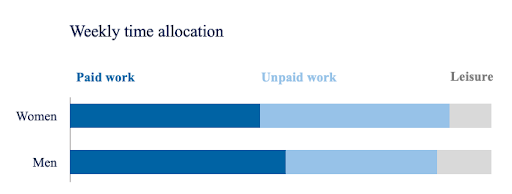The problem: Despite significant improvements in gender equality, the gender pay gap persists worldwide.
Why it matters: Due to gender roles and social stereotypes, women spend a disproportionate amount of time on unpaid care work, negatively impacting their career development and wages.
The solution: Family-friendly policies that promote affordable access to child care, paid family leave, and flexible work schedules are essential to achieve real gender equality in the labour market.
Over the last few decades, women have significantly increased their participation in the labour market. They have outpaced men in college enrollment, and they are becoming more represented in traditionally male-dominated positions. Yet the gender pay gap persists all over the world. For instance, in the United States, women earn on average 80.5% of men’s wages.
Typically, women and men enter the labour market near income parity. However, once women are left to deal with time-consuming family responsibilities, such as caregiving for children or elders, they tend to reduce their paid work, creating a work-experience gap between men and women, and a decrease in women’s income. While the unequal distribution of unpaid work has not always been considered in gender pay gap policies, recent studies highlight the value in considering the “double burden” in balancing paid and unpaid work that women disproportionately face.
When “time is money” is not for everyone
As shown in Figure 1, compared to men, women devote a disproportionate amount of time to unpaid work, such as caregiving and domestic chores. Consequently, their workdays expand on average by 2.3 hours, a phenomenon known as the “second shift”. While the way men and women spend their time can be an individual choice, studies suggest that social norms and gender stereotypes have a strong influence on employment decisions and constraint women’s ability to participate in the labour market.

Discriminating, just in case
The reality that women suffer work interruptions more frequently than men coupled with gender stereotypes incentivises gender discrimination in the labour market. Evidence shows that women without children earn 96% of their male counterparts’ wages, while married women with one or more children earn only 76% of their male counterparts’ wages. This discrimination manifests not only in the pay gap, but also in less training for women and fewer opportunities for promotions. i.e., employers may infer that women candidates will need to stop working temporarily for caregiving responsibilities. Thus, it is likely that the organisation invests fewer resources in women’s career development.
Changing women’s misperceptions through education, culture shifts, and female leadership is needed but not enough to eradicate gender discrimination. It will persist as long as hiring men makes more financial sense than hiring women. Therefore, a more equal distribution of unpaid care work is the key. Following a new work distribution formula, women would be less associated with unpaid domestic roles and men would have new opportunities to assume family responsibilities.
Policymakers should mitigate the gender pay gap by designing family-friendly policies that both promote an equal distribution of unpaid care work between men and women, and address work-family conflicts encouraging mothers to stay connected to the labour market. Essential work-family policies are child care programmes, paid family leave, and flexible, but predictable, paid work schedules.














